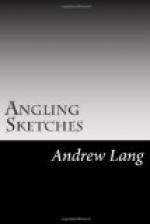When you reach Kinross, and, after excellent ham and eggs, begin to make a start, the cockney element is most visible at the first. Everybody’s name is registered in a book; each pays a considerable, but not exorbitant, fee for the society—often well worth the money—and the assistance of boatmen. These gentlemen are also well provided with luncheon and beer, and, on the whole, there is more pleasure in the life of a Loch Leven boatman than in most arts, crafts, or professions. He takes the rod when his patron is lazy; it is said that he often catches the trout; {1} he sees a good deal of good company, and, if his basket be heavy, who so content as he? The first thing is to row out to a good bay, and which will prove a good bay depends on the strength and direction of the wind. Perhaps the best fishing is farthest off, at the end of a long row, but the best scenery is not so distant. A good deal hangs on an early start when there are many boats out.
Loch Leven is a rather shallow loch, seldom much over fifteen feet deep, save where a long narrow rent or geological flaw runs through the bottom. The water is of a queer glaucous green, olive-coloured, or rather like the tint made when you wash out a box of water-colour paints. This is not so pretty as the black wave of Loch Awe or Loch Shin, but has a redeeming quality in the richness of the feeding for trout. These are fabled to average about a pound, but are probably a trifle under that weight, on the whole. They are famous, and, according to Sir Walter Scott, were famous as long ago as in Queen Mary’s time, for the bright silver of their sides, for their pink flesh, and gameness when hooked. Theorists have explained all this by saying that they are the descendants of land-locked salmon. The flies used on the loch are smaller than those favoured in the Highlands; they are sold attached to casts, and four flies are actually employed at once. Probably two are quite enough at a time. If a veteran trout is attracted by seeing four flies, all of different species, and these like nothing in nature, all conspiring to descend on him at once, he must be less cautious than we generally find him. The Hampshire angler, of course, will sneer at the whole proceeding, the “chucking and chancing it,” in the queer-coloured wave, and the use of so many fanciful entomological specimens. But the Hampshire angler is very welcome to try his arts, in a calm, and his natural-looking cocked-up




